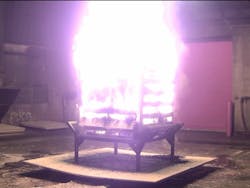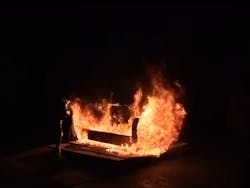Research Corner: Bridging the Gap Between Training Fuels and Furniture
Take a look at the furniture that’s inside of your own home or even your fire station dayroom. Chances are, it’s constructed of synthetic materials, such as polyester, polyurethane and polystyrene. Research shows that these materials tend to burn faster, release more energy and generate more unburned fuel than the natural materials, such as cotton, wool and solid wood, out of which older furnishings are made. When firefighters and researchers discuss the differences between these two types of fuels, it often is in the context of residential fireground operations: Modern homes that are filled with synthetic furnishings are more likely to reach a ventilation-limited state earlier in the incident and, subsequently, to shorten the fire service’s operational time frame.
Although it’s important to acknowledge and understand how this shift in materials affects the residential fireground, an often-overlooked facet of this equation is that these modern, synthetic fuels also are different than the fuels that firefighters use for live fire training.
Heat release rate
It is difficult to talk about live fire training without discussing NFPA 1403: Standard on Live Fire Training Evolutions. NFPA 1403 outlines the minimum requirements for conducting live fire training in fixed-facility and acquired structures. A key requirement is that only wood-based products that are known or have well-characterized burning behavior should be used as part of the training fuel package.
A common criticism of using wood-based training fuels is that the fires that are produced by these fuels aren’t representative of the fires that are seen in contemporary homes. With many departments across the country responding to fewer fires than in years past, live fire training must be an important element of preparing firefighters for the challenges that they face on the fireground.
When comparing different fuel packages, a useful metric is the heat release rate (HRR). The HRR is the rate at which a fire releases energy, measured in megawatts (MW). Compartment effects (floor area, walls and ceiling height), ventilation configuration (size and orientation) and fuel load (weight and orientation) all can affect HRR. For a fixed set of compartment and ventilation conditions, fires that have higher peak HRRs would be expected to become ventilation-limited and to possibly transition through flashover; fires that have lower peak HRRs might not become ventilation-limited nor reach flashover.
To compare the HRR of NFPA 1403-compliant training fuel packages to synthetic furniture items, experiments were conducted in Underwriters Laboratories’ calorimetry lab in Northbrook, IL. These experiments were conducted in a free-burn configuration, which means that they were conducted without walls or a ceiling present.
UL Firefighter Safety Research Institute (UL FSRI) evaluated 21 NFPA 1403-compliant training fuel packages and 12 furniture items. The furniture items included two types of upholstered sofas, three types of upholstered chairs and a queen-size bed set. The training fuel packages were composed of various combinations of wood pallets, straw, excelsior, oriented strand board (OSB), medium-density fiberboard (MDF) and dimensional lumber.
In general, the results showed that as the weight of the training fuel package increased, the peak HRR also increased. However, fuel orientation also has an important impact on HRR. For example, three different configurations of three pallets and one bale of straw were examined. The orientation of the fuel was varied between pallets that were stacked in a triangle, horizontally and vertically. These peak HRRs varied from 1.2–2.1 MW. Although the weight of these fuel packages was approximately the same and the total energy that was released through the duration of the burn was similar, the rate at which that energy was released varied depending on the orientation of the fuel. If these three fuel packages were ignited in a compartment, they would produce different fires, particularly with respect to the time at which peak conditions occur.
Although initial fuel weight of the training fuel packages couldn’t be used to accurately predict the peak HRR (see previous point about orientation), the weights could be used to compute the effective heat of combustion for each of the fuel packages. This metric describes the amount of energy that a fuel releases during combustion, per unit mass, and is expressed in units of megajoules per kilogram (MJ/kg). The results of these experiments show that the effective heat of combustion was approximately constant among the NFPA 1403-compliant training fuel packages that were examined. In essence, the energy content of the type of wood that was used, including engineered wood products, such as OSB and MDF, didn’t vary significantly. The differences in fuel orientation and geometry are responsible for the differences in fire behavior that newer fuels produce.Heat of combustion
Heat of combustion also is an important property when considering the difference between wood-based training fuels and synthetic fuels. Synthetic materials tend to have a higher heat of combustion than their wood-based counterparts have. This means that for the same mass of fuel, the synthetic fuel can release more energy. Despite this, the training fuel packages that were tested in this study had peak HRRs that were comparable to furniture items that were tested. Figure 1 shows where different training fuel packages and furniture items fall on a spectrum of HRRs. Training fuel packages that range from a single bale of straw (34 lbs.) to seven pallets and one bale of straw (297 lbs.) had peak HRRs that varied from 1.0–3.8 MW. The peak HRR of the furniture items that weighed between 19–232 lbs. ranged from 0.9–3.7 MW.
Training fuel packages that are composed of three or four pallets and one bale of straw had similar peak HRRs to an upholstered chair. Slightly larger fuel packages that had three pallets, one bale of straw and two sheets of either OSB or MDF had peak HRRs that were greater than a single chair yet less than that of an upholstered sofa. The largest training fuel packages that were evaluated—six or seven pallets and one bale of straw in various orientations—had peak HRRs that were comparable to or greater than an upholstered sofa. To further put these numbers into context, the peak HRR of many of these training fuel packages is sufficiently high enough to generate flashover conditions in a typical residential room.Too much synthetic fuel
Although the peak HRRs of these training fuel packages were comparable to individual furniture items, there are several important differences between the two types of fuels. Unlike wood-based fuels, synthetic fuels require more oxygen for complete combustion. As a result, the smoke that’s produced when synthetic fuels burn typically contains unburned fuel. The greater quantity of unburned fuel has two effects: It produces darker, more optically dense smoke (as shown in Figure 2), and it increases the risk of smoke ignition if mixed with the correct proportion of oxygen. This latter fact makes the response to ventilation of these synthetic fuels more volatile than their wood-based counterparts.
Additionally, although wood-based training fuel packages have peak HRRs that are comparable to furniture items, it would be rare to find a residential room that has a single upholstered sofa or chair. Rather, these rooms often contain several furniture items along with carpet and carpet padding. This high fuel content is part of the reason that residential fires often are limited by the ventilation area as opposed to the amount of fuel: There simply is too much fuel in these rooms for the amount of air that’s available to them. These distinctions between the composition and quantity of fuels are responsible for many of the differences between training fires and actual fires that many firefighters experience. More work is needed to better understand the heat release characteristics of training fuels and how different types of training facilities might result in different experiences. A better understanding of the types of fires that various training fuel packages produce can help instructors to create safe, realistic training evolutions. Additionally, research by UL FSRI is underway to better quantify the cardiovascular and carcinogenic risks of different training fuels. For example, some states banned the use of OSB in live fire training because of exposure concerns from burning the resin that’s part of these fuels. This study will be helpful to understand the tradeoff between exposure concerns and the thermal performance of these fuels.
For more research about the fire service training environment, check out https://ulfirefightersafety.org/research-projects/fire-service-training-environment.html.
About the Author
Jack Regan
Jack Regan holds a bachelor's degree in civil engineering from the University of Illinois and a master's degree in fire protection engineering from the University of Maryland. He has worked on projects that examined occupant tenability and firefighter training.



